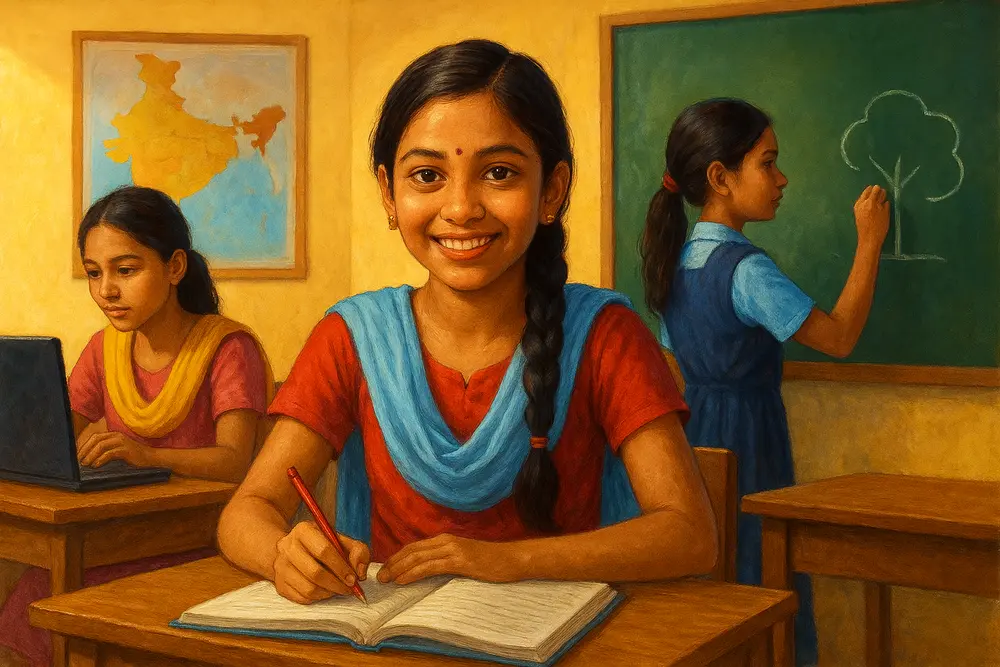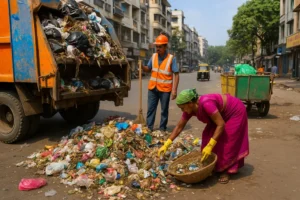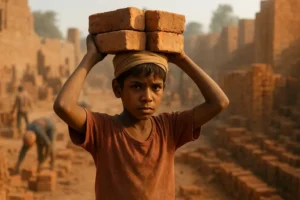How can India ensure that every girl gets equal access to quality education in 2025 and beyond? The answer lies in removing barriers that hold girls back—poverty, safety concerns, social norms, and lack of resources.
Education for girls is not just about going to school; it’s about giving them confidence, opportunities, and the power to shape their futures. When girls learn, families prosper, and communities grow stronger.
In this article, we’ll explore practical strategies, real challenges, and future opportunities to make education truly accessible for every girl in India.

How to Improve Access to Quality Education for Girls in India in 2025: Challenges, Solutions and the Road Ahead
Imagine a classroom in rural India in 2025: dusty floors, basic furniture, a few children sharing textbooks, maybe one or two computers tucked in a corner.
Despite these modest resources, you’ll often find girls there—some walking several kilometers to reach school, others juggling home chores before or after class. Their presence isn’t just a sign of hope—it’s a declaration of potential.
Educating girls isn’t just “nice to have”; it changes lives, communities, even the entire fabric of society.
India has made progress over the last decade. We’ve seen higher enrolment rates, more girls clearing secondary school exams, government schemes aimed specifically at girl children, and increasing awareness about how education for girls benefits everyone. But many barriers remain.
As we move through 2025, improving access to quality education for girls is still a top priority—because access alone isn’t enough; quality matters, retention matters, equity matters.
In this article, we will explore where we are now, what are the obstacles holding girls back, and, crucially, what we can do—through policy, community, technology, partnerships—to ensure girls in India can access real quality education. The hope is you’ll have both a deeper understanding and some actionable ideas—whether you’re a policymaker, educator, NGO worker, or just someone who cares.
Current Landscape of Girls’ Education in India
Girls’ education in India has made significant progress, with rising enrolments and supportive policies. Yet, gaps remain in quality, retention, and access, especially in rural areas, highlighting the urgent need for sustained, inclusive efforts.
Before charting paths forward, it helps to understand where things stand.
Enrolment & Participation Trends
- Since 2014-15, girls’ enrolment in school has increased by roughly 31%. Union Education Minister Dharmendra Pradhan reported in the Rajya Sabha that female school enrolment in India has increased by 31% since 2014-15.
- In many states, more girls are enrolling in higher education than boys. For example, in Uttar Pradesh in the 2023-24 session, there were about 1,38,499 more girls than boys entering college. A report from Uttar Pradesh’s Higher Education Department states that in the 2023-24 session, 54,76,441 students enrolled in colleges: 28,07,470 girls and 26,68,971 boys — which is 1,38,499 more girls than boys.
- Also, girls are outperforming boys in Class 12 board exams, across social groups. For instance, from 2013 to 2024 the number of girls scoring above 60% nearly doubled. According to data released by the Ministry of Education: students scoring above 60% in Class 12 rose from 43.1 lakh in 2013 to 80 lakh in 2024. Among these, girls increased from 21.9 lakh to 42.8 lakh — nearly doubling.
Government Schemes & Initiatives
India has many schemes aimed at supporting girl children:
- Beti Bachao Beti Padhao – focuses on awareness, reducing gender-biased sex selection, and promoting education.
- Sukanya Samriddhi Yojana – savings scheme for girl children, intended to help with future education and marriage expenses.
- National Scheme of Incentives to Girls for Secondary Education – financial support to promote enrolment and retention in secondary school, particularly for SC/ST girls.
Performance and Quality Data
- Reading proficiency: Girls in middle‐income countries, including India, tend to outperform boys in reading, especially in early/middle grades. UNESCO’s2023-24 Global Education Monitoring (GEM) report noted “As a global average, girls are now outperforming boys in reading across all education levels and country income groups. On average, only 87 boys attain the minimum reading proficiency level for every 100 girls.
- Gaps remain in mathematics and in leadership roles: girls are underrepresented in academic leadership (e.g. vice-chancellors, directors).
Gaps & Disparities
- Rural vs Urban: Access in rural areas is still far more challenging—distance to school, quality of infrastructure, fewer trained teachers, etc.
- Social groups: SC, ST, and minority communities still lag behind in both enrolment and learning outcomes.
- Dropouts: Though many girls enrol, keeping them in school through secondary and into higher education is still a struggle.
- Cost & affordability: Even when school is “free,” indirect costs (uniforms, books, transport) or hidden costs (private coaching) are burdensome. A study in 2025 showed average expenditure per student in rural India was ~₹9,033 for boys vs ~₹7,660 for girls; in urban areas numbers are much higher (boys ~₹24,788 vs girls ~₹21,997).
Top Challenges Girls Confront in Getting Quality Education in India
Despite progress, many girls in India still face hurdles in getting quality education. Poverty, safety concerns, cultural barriers, and digital divides continue to block opportunities, reminding us that access alone isn’t enough—real change needs deeper, lasting solutions.
Understanding the obstacles clearly helps in designing effective solutions. Here are some of the biggest ones:
Socio-cultural Barriers:
- Gender norms and expectations: In many households, girls are expected to help with chores, care of siblings or elders, or are discouraged from staying in school when families are under economic stress.
- Early marriage and adolescent pregnancies still affect school retention.
- Preference for investment in boys’ education over girls’, especially for higher grades.
Economic Barriers:
- Poverty remains a major barrier. Even when there are scholarships, some costs aren’t covered.
- Indirect costs such as uniforms, books, transport, private coaching.
- Opportunity cost: girls often lose study time because they are expected to contribute to household labour (fetching water, cooking, etc.).
Infrastructure Gaps:
- Physical access: schools might be far away, especially in remote or hilly regions. Lack of safe transport is a deterrent.
- Facilities: separate, hygienic toilets for girls; safe school environment (lighting, security) are essential but often lacking.
- Digital infrastructure: in many rural or impoverished urban areas, electricity, reliable internet, devices are limited.
Quality Concerns:
- Teacher availability and training: shortage of well-trained female teachers (important for girls’ comfort and retention), insufficient capacity for remedial or supportive teaching.
- Curricula and pedagogy: sometimes outdated or not tailored to local contexts; lack of learner-centred, inclusive pedagogy.
- Learning outcomes: enrolment is improving, but foundational skills (reading, arithmetic) are not uniformly strong across states and social groups.
Technology & Digital Divide:
- During COVID-19, many schools moved online or adopted hybrid models; however, girls in poorer households often lacked devices or internet access, exacerbating inequity.
- Even where devices exist, digital literacy (parents, teachers, girls themselves) is uneven.
Policy & Implementation Gaps:
- Schemes exist, but sometimes the implementation is weak: delays, leakage, inadequately targeted programs.
- Monitoring & evaluation is often insufficient; data is either delayed, not disaggregated (by gender, caste, region), or not used effectively.
Why Ensuring Quality Education Access for Girls Is Crucial
Ensuring quality education access for girls in India is not just about classrooms—it’s about breaking cycles of poverty, empowering futures, and shaping stronger communities. When girls learn, families thrive, societies progress, and economies grow. Education becomes the foundation for equality, dignity, and lasting change.
Let’s explore why this is such an urgent issue. Because the benefits are both deep and wide-ranging.
- Individual benefits: Educated girls are more likely to stay healthy, delay marriage, have fewer children, make informed choices about their lives. Education gives them agency.
- Economic benefits: Educating girls raises labour force participation, improves productivity, increases family incomes, reduces poverty.
- Social benefits: Girls’ education has multiplier effects—it improves outcomes for their children, contributes to more equitable societies, reduces gender inequalities.
- Achievement of SDGs: Especially SDG 4 (Quality Education) and SDG 5 (Gender Equality). Access + quality supports achieving those national and international goals.
- Resilience & future readiness: With changing job markets, technological shifts, global challenges like climate change, girls need strong education to adapt, contribute, lead.
Read Here: Role of Education in Promoting Gender Equality
Solutions and Strategies to Improve Access to Quality Education for Girls in India
Improving access to quality education for girls in India isn’t about one magic fix—it’s about combining many practical strategies. Here are practical, evidence-based strategies that can help move the needle.
Make Schools Safe and Welcoming
For many girls, distance and safety concerns are dealbreakers. Well-lit campuses, separate toilets, and secure transport can reassure families. When parents see schools as safe spaces, girls not only attend regularly but also participate more freely, enjoying the learning process.
Recruit and Support More Female Teachers
Having women teachers changes everything. Girls feel more comfortable sharing problems, parents trust schools more, and role models are right in front of them. Training, incentives, and career growth opportunities can attract talented women into classrooms, especially in rural India.
Offer Scholarships and Cash Incentives
Money matters. Many families withdraw girls due to costs—uniforms, books, travel. Conditional cash transfers, stipends, or scholarships tied to attendance encourage parents to prioritize girls’ education. When financial stress reduces, families proudly watch their daughters continue their studies with dignity.
Introduce Flexible Learning Models
Not every girl can follow a strict timetable—especially those helping with chores or work. Flexible schedules, evening classes, and bridge courses help them catch up. Education tailored to their realities ensures that temporary setbacks don’t end schooling forever.
Leverage Digital and Mobile Learning
Imagine a girl in a remote village accessing math lessons on her phone, even offline. Affordable devices, free educational apps, and regional-language content bridge the digital divide, making technology a true equalizer for girls left behind by geography.
Strengthen Community Awareness Campaigns
Change begins at home and spreads in neighborhoods. Awareness drives highlighting educated women’s success stories inspire families. When communities see how education uplifts entire households, resistance softens, and schooling becomes a shared dream, not just a girl’s personal struggle.
Provide Vocational and Skill-Based Training
Education isn’t only about textbooks. Adding skill training—tailoring, coding, financial literacy—makes learning more practical. Parents value it, girls see career paths ahead, and communities respect educated daughters as contributors, not dependents. This mix of academics and skills builds real empowerment.
Build Hostels and Safe Accommodation
For many rural girls, schools are too far. Hostels near secondary schools and colleges, with caring wardens, safe transport, and supportive communities, make higher education possible. A secure stay option often means the difference between dropping out and pursuing dreams.
Encourage Parent-Teacher Partnerships
Schools work best when parents are allies. Regular meetings, home visits, and joint activities build trust. When mothers and fathers see teachers as partners, they invest more in their daughters’ progress, celebrate achievements, and stand against pressures that could derail schooling.
Introduce Mentorship and Peer Networks
Imagine a village girl guided by an older student who once walked her path. Mentorship provides encouragement, career advice, and confidence. Peer-support clubs and alumni connections create sisterhoods that remind girls they’re never alone in their educational journeys.
Strengthen Monitoring and Accountability Systems
Policies and funds alone don’t guarantee results. Transparent tracking of enrolment, attendance, and outcomes ensures no girl is lost in the system. Dashboards, local committees, and real-time alerts can trigger quick interventions whenever a student is at risk of dropping out.
Promote Media and Role Model Campaigns
Seeing is believing. Media campaigns showcasing female scientists, teachers, entrepreneurs, and leaders inspire girls to dream big. These stories also challenge societal stereotypes, nudging families to imagine brighter futures for their daughters beyond traditional roles and expectations.
Strengthen existing acts and policies
Ensure robust implementation of the Right to Education (RTE) Act in terms of infrastructure, teacher-student ratios, accountability.
Better enforcement of school attendance, especially for girls; possibly linking financial incentives to retention rather than just enrolment.
The Role of Parents, Society, and Media
These often get less attention than policies or tech, but they are powerful levers of change.
- Parents: Key influencers. If parents believe in girls’ education, they will send them, protect them, support them. Providing awareness programs directly to parents (including fathers) can have big impact.
- Society & community norms: Social expectations regarding what girls “should” do, marriage, domestic responsibilities, safety can either hinder or help. Communities that value girls’ education tend to see better retention.
- Media & stories: Showcasing successful women (from rural/poor backgrounds), positive examples of families investing in daughters; using films, television, social media to change narratives.
Future Outlook: Girls’ Education in India Beyond 2025
The future of girls’ education in India is poised at a critical juncture—marked by both promising transformations and persistent challenges.
What might the next few years bring?
Expansion of Digital and AI-Based Learning:
India will see wider use of AI-driven platforms and adaptive learning tools, offering personalized education for girls. Regional language content and mobile accessibility will reduce learning gaps, especially in rural areas, making quality education more inclusive and resilient to disruptions.
Growth of Hybrid Education Models:
Blended learning—mixing classroom, digital, and community-based methods—will strengthen resilience against climate disruptions or pandemics. Girls in remote areas will benefit from flexible formats, reducing dropout rates and offering continuity in education even when traditional schooling is interrupted by local challenges.
Focus on Skills and Employability:
Beyond academics, schools will increasingly integrate vocational training, STEM exposure, and life skills into curricula. This shift will prepare girls not only for higher education but also for meaningful careers, bridging the gap between schooling and workforce participation in India.
Women in Leadership and Policy Roles:
With more women assuming leadership positions in academia, education boards, and policymaking, decisions will reflect greater gender sensitivity. Their presence will ensure stronger advocacy for girls’ education, curriculum inclusivity, and better accountability in schemes designed to support female students across India.
Data-Driven Monitoring and Accountability:
Improved education data systems will track enrolment, attendance, and learning outcomes at granular levels. Real-time dashboards will help policymakers identify risks of dropout early, target resources efficiently, and ensure that interventions genuinely improve girls’ access, retention, and educational achievement nationwide.
Strengthening Social and Community Movements:
Grassroots campaigns will amplify stories of successful educated women, normalizing aspirations for girls. Peer-support groups, youth clubs, and mother-teacher associations will reshape community norms, reducing resistance to girls’ education, especially in conservative or resource-poor areas where social barriers remain.
International Collaboration and Global Standards:
India will collaborate more with global education networks, adopting best practices in equity, technology, and pedagogy. Exposure to international benchmarks will push reforms that not only expand access but also improve quality, ensuring Indian girls remain competitive on the world stage.
If India stays committed, it is possible to approach universal access to quality education for girls by 2030—with caveats: quality must improve, inequities must be addressed, and the enabling environment (social, economic, infrastructural) must support that access.
Read Here: How Social Class Affects Educational Outcomes
Conclusion
Access to quality education for girls is not just a policy goal—it’s a moral imperative and a smart investment.
India in 2025 stands at an inflection point: many of the barriers are known, many of the solutions are available, and the evidence is clear that change is happening.
But pockets of disadvantage remain, and unless efforts are consistent, locally adapted, and inclusive, we risk leaving too many behind.
Moving forward, we need collective action: policymakers to sharpen and implement policies well; communities to support girls; teachers to be empowered and supported; technology and infrastructure to close gaps; parents and media to shift mindsets. It’s only together that we will ensure that every girl in India—not just those in cities or in advantaged families—gets the education she deserves: accessible, high-quality, relevant, and transformative.
Read Here: How Lack of Education Affects Tribal Communities in India
FAQs
Q1: Why is girls’ education especially important in India right now?
Because India is young (very large youth population), facing rapid economic and social transitions. Educated girls contribute to better health, workforce, equality, and help India meet its development goals (SDGs). Also, gender gaps are closing but need acceleration.
Q2: What are the main barriers to girls’ education in rural areas?
Distance to school, lack of transport, poor infrastructure (toilets, safe classrooms), gender norms (household chores, early marriage), cost of schooling (books, uniforms), and digital divide.
Q3: How can technology improve access to education for girls?
By enabling remote learning, providing affordable devices and internet, using adaptive learning tools tailored to individual needs, creating mentorship platforms, offering educational content in regional/local languages.
Q4: Which government schemes currently help girls’ education in India?
Some key ones are Beti Bachao Beti Padhao; Sukanya Samriddhi Yojana; National Scheme of Incentives to Girls for Secondary Education; and state-level initiatives like UP’s Rani Laxmi Bai Scooty Yojana. These provide financial incentives, support, awareness, etc.
Q5: How does educating girls impact the economy?
Educated girls are more employable, earn more, contribute to household income. Nations with higher female literacy and higher female labour force participation tend to have higher GDP growth. Also, reductions in health costs, lower birth rates, better outcomes across generations contribute to economic stability.
Q6: What role do parents play in ensuring girls’ education?
Parents make decisions about schooling, safety, retention, spending. Their awareness, values, and support (emotionally and financially) are crucial. Parent-teacher communication, local community involvement, role models can influence parents to invest in daughters’ education.
Q7: What are some best practices from NGOs or states that have succeeded?
- Incentive/scholarship programs targeted to disadvantaged girls.
- Safe transport or hostels.
- Female teacher recruitment.
- Strong community participation (monitoring attendance, changing norms).
- Use of technology to reach remote areas and support remedial learning.
Q8: Is universal girls’ education by 2030 achievable for India? What needs to happen?
Yes, but only if multiple things align: consistent policy implementation; sustained funding; closing infrastructure gaps; focusing on quality and learning outcomes, not just enrolment; shifting social norms; leveraging technology appropriately; strong data systems and monitoring.





